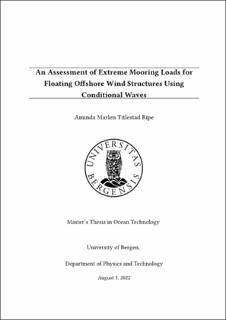| dc.description.abstract | Wind power is one of the fastest-growing industries in the world and plays a significant role in the transition to sustainable energy systems. However, the costs of substructures and moorings limit the potential of floating wind turbines to be placed at depths greater than 60 m with stronger and steadier winds. Experimental tests on two types of foundations for floating wind turbines at 1:100 scale representing a full-scale water depth of 220 meters have been tested in irregular sea states and conditional waves to study the relationship between local wave characteristics and extreme response and mooring loads. Both models are moored using a light mooring system mounted above the still water level, where the slack mooring lines for a spar buoy frequently induce snap loads, compared to a tauter mooring system for a semi-submersible float avoiding snap loads in all three sea states. \\ The irregular waves are modeled using JONSWAP spectra representing 50-year storm conditions. The conditional waves consist of a focused wave group embedded in a random background sea, called the Most likely Wave (MLW), and two wave series conditioned on the floater's transfer functions called the Most Likely Response Wave (MLRW) and Conditional Random Response Wave (CRRW). The conditional waves need new methods when calibrated to ensure their properties are preserved, whereas the methods used are experimental and cause significant uncertainties in the results. Still, the recorded mooring loads and responses at the focal time in MLRW and CRRW are higher for both models than recordings at the focal time in the MLW, indicating that the most extreme events do not necessarily arise from extreme wave heights. This is supported by findings in the 3-hour sea-states, where the top ten mooring loads in all three sea-states appear to correlate with the devices' dominant behavior. The spar buoy is as well modeled in OrcaFlex in full-scale using experimental parameters as input. OrcaWave is used to compute the hydrodynamic coefficients, and the system characteristics in OrcaFlex are tuned after experimental decay tests. Despite a good agreement between the numerical and experimental decay tests, the short-term response statistics are severely underpredicted. | |
